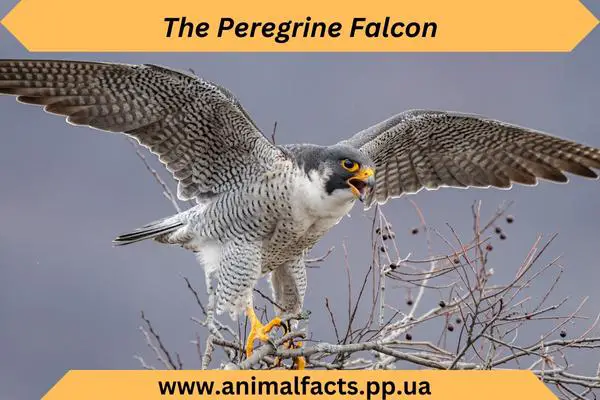The peregrine falcon is renowned as the fastest animal on the planet and its unbelievable diving speeds are a major reason for this title. When hunting in a dive, peregrines can reach speeds of over 200 mph, making them the fastest diving bird in the world.
Introduction to the Peregrine Falcon
The peregrine falcon (Falco peregrinus) is a powerful bird of prey found across most of the world. With its slate-blue back and barred white underside, adults have a distinct appearance. Peregrines thrive in various habitats from tropical rainforests to the Arctic tundra.
These skilled hunters feed primarily on other birds, which they capture mid-flight. Peregrines hunt from perches or while hovering before going into steep dives when pursuing prey. Their long, pointed wings enable incredible speeds in these hunting stoops.
Fastest Diving Speeds of Any Bird
During dives, called stoops, peregrines can reach speeds over 200 mph (320 km/h), making them the fastest-moving creatures on Earth. This is far faster than the top speeds of the fastest land animal, the cheetah, which can run around 75 mph (120 km/h).
Peregrines achieve these phenomenal diving speeds due to:
- Streamlined body shape – Their slim, tapered wings and teardrop-shaped body minimize drag and maximize speed during dives.
- Diving technique – Peregrines typically dive at very steep angles, approaching 60-90 degrees. This near-vertical dive angle further amplifies their velocity.
- Strong wings – Their long, broad wings are powered by large pectoral muscles that provide tremendous thrust and control while diving.
- Windy habitats – Peregrines often hunt along ocean cliffs and mountain ranges where updrafts and wind shears aid their acceleration during dives.

Measuring Diving Speeds
Researchers have used various techniques over the years to precisely measure the velocities of peregrines in hunting dives:
- High-speed cameras – Recording dives at hundreds of frames per second allows accurate dive speeds to be calculated.
- GPS devices – Miniaturized GPS loggers attached to falcons can track diving metrics like speed, duration, and angle.
- Wind tunnels – Diving aerodynamics and speeds have been tested using preserved peregrine bodies and wings in wind tunnels.
- Radar – Military radar systems have recorded some of the highest known peregrine stoop speeds.
Record Diving Speeds
The peregrine falcon is renowned for its incredible stooping speeds when diving vertically on prey. Some of the highest reliably recorded speeds include:
- 242 mph (389 km/h) – This is the highest published speed recorded by radar in a diving peregrine. It was measured during a dive at the Naval Air Weapons Station in China Lake, California in 1975.
- 203 mph (326 km/h) – National Geographic researchers recorded this speed in a diving falcon using a specialized GPS data logger in 2005. It is one of the highest speeds measured for the species.
- 168 mph (270 km/h) – Most studies have found average hunting dive speeds of peregrines to be around 168 mph, with variations based on dive angle and height.
- 112 mph (180 km/h) – This is considered the minimum speed a peregrine needs to successfully catch fast, agile prey like ducks on a stoop. Slower dives may not overtake speedy birds.
Impacts of High Speed Dives
The incredible speeds of peregrine stoops enable them to catch fast-flying prey like pigeons. However, it does put strain on their bodies requiring special adaptations like:
- Shock-absorbing cartilage – Shock-absorbing cartilage in their nostrils to handle the massive wind pressures without injury.
- Tear ducts – Tear ducts that secrete protective oil during dives to coat their eyes from drying out and damage at high air speeds.
- Tough breast muscles – Powerful breast muscles which can withstand the extreme G-forces exerted on impact with prey. Their muscle strength prevents internal organ damage.
- Advanced aerodynamics – Specially shaped nostrils, small ears, and streamlined feathers to optimize their aerodynamics during stooping dives.
Hunting Using High Speed Dives
Peregrines mainly catch other mid-air birds using their stooping dives. The speed enables them to overtake fast-flying prey, while the force of impact strikes or knocks out targets. They also rely on surprise and precision when diving on prey.
Some key facts about their hunting strategy include:
- Target. They mainly target other flying birds like pigeons, doves, ducks, shorebirds, and even other raptors.
- Dive from above. Peregrines gain height above their target prey, remaining unseen. They then tuck in their wings and unleash a nearly vertical stoop.
- Deadly impact. On impact, they either strike the target with feet outstretched or knock them out mid-air using the force of collision.
- Aerial agility. Their steering tail allows swift turns and adjustments during the dive to precisely line up strikes.
- Strong talons. Strong, razor-sharp talons ensure a firm grip to catch and carry off prey after collisions.
Conclusion
With its streamlined build, powerful wings, and perfected hunting technique, the peregrine falcon is a master of diving at phenomenal speeds. By using gravity, wind, and the element of surprise, peregrines can exceed 200 mph in near-vertical hunting stoops, making them the fastest diving bird.
Their ability to catch other agile birds mid-flight demonstrates the effectiveness of using incredibly high speeds in nature. The peregrine is an iconic predator that continues to hold the record for the fastest dive on Earth. Learn here more about birds facts and data.


